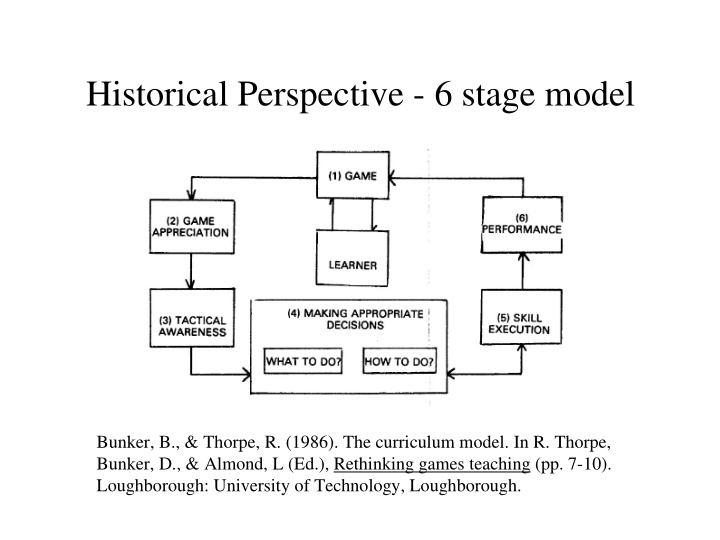



Historical Perspective - 6 stage model Bunker, B., & Thorpe, R. (1986). The curriculum model. In R. Thorpe, Bunker, D., & Almond, L (Ed.), Rethinking games teaching (pp. 7-10). Loughborough: University of Technology, Loughborough.
Where Does the Game Appear in the Lesson? - 3 stage m0del Game Form (Representation, Exaggeration) Tactical Awareness Skill Execution Griffin, L. L., Mitchell, S. A., & Oslin, J. L. (1997). Teaching sport concepts and skills : A tactical games approach . Champaign, IL: Human Kinetics.
Game performance becomes… • Decision making • Supporting • Marking or guarding • Covering teammates • Adjusting position as game play unfolds • Ensuring adequate court or field coverage by a base position (p. 12)
Games frameworks - Key questions Griffin et al. framework 1. What problems does this game present for scoring, preventing scoring, and restarting play? 2. What off-the-ball movements and on-the- ball skills are necessary to solve these problems?
Defining games • Target – propel an object, with a high degree of accuracy, at a target. • Batting/fielding or run scoring - strike a ball so it eludes defenders • Net/Wall – propelling an object into space so an opponent is unable to make a return. • Invasion or Territory – to invade an opponent’s territory to score. Griffin et. al. (1997, p.9)
Fundamental Skills • Body Management (BM) skills – ie. Running, stopping, balance, guarding... • Equipment Handling (EH) skills – Sending or propelling, ie. throw, strike… – Receiving, ie. catching, trapping… – Retaining, ie. carrying, dribbling…
A Framework for Categorizing Physical Activity Games That Use an Object Key BM - Body management. Also referred to as locomotion or BM - Stability and good EH - Sending away and EH - Sending, receiving and BM - Running, dodging, non-locomotion skills. balance as deliver object aiming retaining (especially as traveling) guarding, stopping and EH - Equipment intercepting handling. Also referred to as For example, manipulative For example, TERRITORY soccer, hockey, skills. TARGET curling, bowling and basketball, rugby golf and football Physical Physical characteristics characteristics OPEN END FOCUSED TARGET (LINE) TARGET(NET) OPPOSED UNOPPOSED PRIMARY RULE PRIMARY RULE (I) score by getting your object(s) closer to a (i) score by getting object into opponents' goal; target than your opponent(s). opponents try to stop scoring. PHYSICAL ACTIVITY GAMES THAT USE BM - Changing direction quickly, EH - Sending EH - Sending-away and AN OBJECT BM - Running, covering, moving in all directions, (striking) and receiving skills stopping, sliding and stopping, guarding and covering preparing to receive guarding BATTING/ For example, NET/WALL For example,tennis, FIELDING baseball, softball, volleyball, squash and cricket and racquetball Physical Physical characteristics characteristics OVAL FAN DIVIDED SHARED PRIMARY RULES: ( i) score by striking object and running between PRIMARY RULE safe areas; stop scoring by catching ball in the air (I) score by getting the object into your opponent's or getting it to a safe area before the batter. areas of play more often than they can return the object back into your area .
Progressive principles play TARGET NET/WALL STRIKING/FIEL TERRITORY/INVASION DING 1. 1. 1. 1. CONSISTENTLY CONSISTENTLY SCORING RUNS SCORE send to target return the object 2. 2. 2. 2. BALL PLACEMENT of PLACEMENT of POSSESSION PLACEMENT object to target and object and other obstacles POSITIONING 3. 3. 3. 3. SPIN and/or SPIN and POWER OUTS INVADE TURN Hopper, T. (1998). Teaching games for understanding using progressive principles of play. CAHPERD, 64 (3), 4-7.
Tactical Awareness Components SPACE (a) where an object should be placed in the area of play, and (b) where a player should go in the area of play based on the placement of the object. TIME (a) when to execute a skill within a game, (b) when to create time to play a shot, and (c) when to reduce opponent’s time. FORCE (a) how much force to apply on an object for height, directional control and distance. (b) how to apply force on an object for height, directional control and distance
Basic Task Model Task
Tactic-skill Progressions • Key ideas. 1. Off-the-ball movements. 2. Awareness of space, time and force components. 3. Modified game that all students can play. 4. Progressive and recursive development of principles. 5. Concepts transfer across games.
Anatomy of a game performance READ Tactical Awareness Decision Making Player decision making Off-the ball movement RESPOND Cover skill selection then skill execution On-the ball REACT Adjust skill selection then skill execution Off-the ball movement RECOVER Base skill selection then skill execution
Review • Reading play - 4 Rs • Tactical Components - Space, force and time • Three phases to game play - Co-op, Compete and To Win • GPAI - Game Performance Assessment Instrument Reading Hopper. (2002). Four R's for tactical awareness: http://www.educ.uvic.ca/Faculty/thopper/WEB/articles Chapter 10 from Griffin text - GPAI.
Lesson plan has… • Task progressions - game, cues, questions • Management tasks - grouping, roles, routines • Organization of equipment and space (diagram) • Phases of a lesson - Intro, skill/concept, culmin. • Objectives (TSWBA) - CAPS learning domains • Administration - Register, jewelry, announcements • Evaluation (Outcomes) - Closure, question CAPS.
Recommend
More recommend